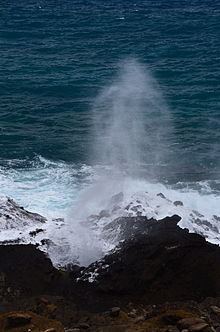 | ||
Similar Halona Beach Cove, Nu‘uanu Pali, Hanauma Bay, Koko Head, Makapuʻu | ||
Hālona Blowhole is a rock formation and a blowhole on the island of Oahu, Hawaii off of Hanauma Bay at Hālona Point overlooking the Pacific Ocean. In Hawaiian hālona means "lookout".
Contents
Map of Halona Blow Hole, Honolulu, HI 96825, USA
On windy days when the tide is high, the ocean breeze sends the waves rolling on to the shore where the rock formation then shoots sea spray high into the air through the cave acting like a geyser. It is not always at its best every day though. The blowhole is most active when the tide is high and the winds are strong. This is a big tourist spot in Hawaii. People come from all over to enjoy the beautiful scenery, the beach at the cove, and in the winter it is the spot to go to see the humpback whale as they take their journey leaving the North Pacific or the Honu (The Hawaiian Green Sea Turtles) swimming about. Diving is possible along the coast when there are light northerly winds blowing and no surf. It is recommended diving elsewhere when waves are breaking. The erratic tidal changes that take place offshore make the waters experience a strong current called Moloka'i Express that can drag divers out to sea. A large wedged shape area right off the coast next to the cove is a reef coated with Sinularia Leather Coral, which is a coral that does not need much light to live, in which you can find many different species like echinoderms, slugs, corals, and eels. The shoreline cliff beyond the cove, ending at a point, should be the limit of any shore diving here due to the strong current and distance. There is also a narrow rift along the base of the cliff which was formed by a large section of rock that broke away from the land can be seen very well on a clear day.
Formation
Thousands of years ago when volcanoes were still active on Oahu, Koko Crater's lava flowed into the ocean there at Hālona Point. The molten lava tubes from volcanic eruptions that occurred thousands of years ago formed the natural occurrence known as the Hālona Blowhole. The lava tubes extend into the ocean which are very narrow at the top, and when the surf is just right, the mighty blowhole can shoot sea spray up to thirty feet high in the air
Hālona Cove
Hālona Cove is the small pit of sand just to the right of Hālona Blowhole(when facing the ocean) where tourists and locals can also enjoy a small beach while visiting the blowhole attraction and it is great for swimming when the surf is very calm. Access to the beach is difficult (most visitors scale the cliff from the parking lot) and it is dangerous to swim here while the surf is rough considering there are no lifeguards on duty here. This was the site of the famous love scene between Deborah Kerr and Burt Lancaster in the 1953 film From Here to Eternity, and also between Drew Barrymore and Adam Sandler in the movie 50 First Dates.
In 2012, the beach was featured in the music video for Nicki Minaj's "Starships".
Dangers
This is also a very dangerous landmark where there have been numerous accidents and even deaths because people did not read warning signs and got too close to the hole. They have since put locked gates up to keep the people from going out onto the rock formation, but tourists and locals still climb the fence. In one example, Daniel Dick, an 18-year-old was vacationing in Hawaii with his family. He was warned by witnesses to stay away and not climb on the rocks. It was said that he wanted to feel the water hit his chest. Thirty seconds later, his wish had been granted and people watched in amazement as he straddled the blowhole. Suddenly, a wave came shooting a blast of water through the hole, launching young Daniel five feet into the air. His body was found the next day. There was a lawsuit in this incident about warning signs. Not only the teen, but four others have been sucked into the blowhole. Three of these incidents have been fatal. Also, below Hālona is one of the most dangerous ocean currents in the world. Its name is Ka Iwi, or commonly the "Molokai Express", for its legendary power to carry the unwary to Molokai . It is very unpredictable and people should not swim there when the ocean current is rough, as the waves crash against rocks.
